| ąĎ¤ů |
y¶Z |
˛Ł«~«¬¸ą |
˛Ł «~ ² ¤¶ |
ˇ@ |
ˇ@ |
ˇ@ |
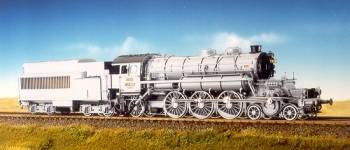
|
HO
|
00300H
|
Baureihe T 18.1002; DRG Deutsche Reichsbahn, Baureihe T 18.1002,
|
|
|
|

|
HO
|
01300H
|
Baureihe H 02.1001; DRG Deutsche Reichsbahn, Baureihe H 02.1001,
|
°â§ą |
|
|
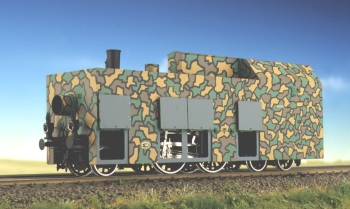
|
HO
|
02104H
|
D XII; Kgl.Bay.StsB.
Königlich Bayerische Staatsbahn, Gattung DXII ‚Panzerzuglokomotive? Vollgepanzerte-verkleidete Version der Wehrmacht WW I, Tarn-Buntfarbenanstrich, Krauss & Company/München 1901, Bauzustand 1918, Zweizylinder-Naßdampftriebwerk
|
|
|
|
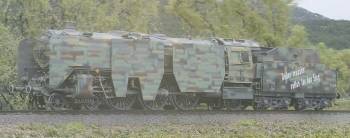
|
HO
|
02206H
|
Baureihe 01.013, DRG Deutsche Reichsbahn, BR. 01, 1. Lieferlos, No. 01.013
|
°â§ą |
|
|
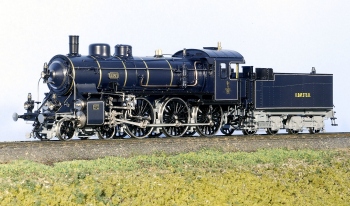
|
HO
|
02500H
|
S 3/5 H; No. 3329
Königlich Bayerische Staatsbahn, Gattung S 3/5 H, No. 3329, Schnellzuglokomotive, J. A. Maffei/München 1906, Bauzustand 1906, Tender 2''2T21,8, Vierzylinder-Triebwerk, Heißdampfversion, Landesgewerbeausstellung Nürnberg 1906,
|
|
|
|
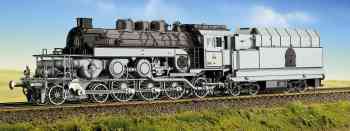
|
HO
|
03300H
|
Deutsche Reichsbahn, Baureihe T18.1001, Dampfturbinen-Schnellzuglokomotive, Krupp/Essen 1923, Bauzustand 1923, flache Rauchkammertür, Tender 2'2T19.5 Kondens, Ursprungsversion mit Seitenverkleidung, Rbd. Essen/Bw. Hamm, Grau/Dunkelgrau/Schwarz.
|
°â§ą |
|
|

|
HO
|
03302H
|
Baureihe T18.1001; DRG. Deutsche Reichsbahn, Baureihe T18.1001, Dampfturbinen-Schnellzuglokomotive, Tender 2'2T19.5 Kondens, Windleitbleche, 1. Umbau ohne Seitenverkleidung, Rbd. Essen/Bw. Hamm, Schwarz/Rot.
|
°â§ą |
|
|
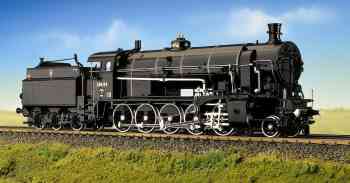
|
HO
|
03601H
|
Reihe 580, SB 580.04
Österreichische Südbahn, Reihe 580, No. 580.04, StEG 1912, Bauzustand 1914, Zweizylinder-Zwillingstriebwerk, Tender 3-achsig, Reihe 356, Schwarz/Schwarz, polierte Messingkesselbänder
|
°â§ą |
|
|
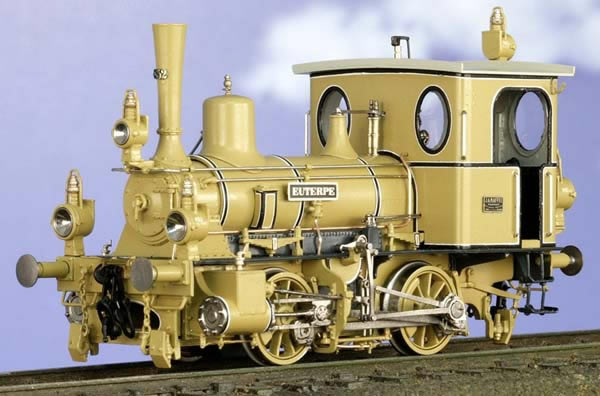
|
HO
|
04100H
|
One of the more popular time periods to model is Era I. Era I is desirable because it deals with many of the private state railways from the years 1835 to 1925. The Bavarian State Railways is among the most exciting railways to model in this time period because they incorporated many unique and impressive steam locomotives which were painted in exquisite liveries. The DVI was built in 1880 by J. A. München and it was designed to be used on small local branch-lines hauling both local passenger service and light branch-line freight.
|
°â§ą |
|
|
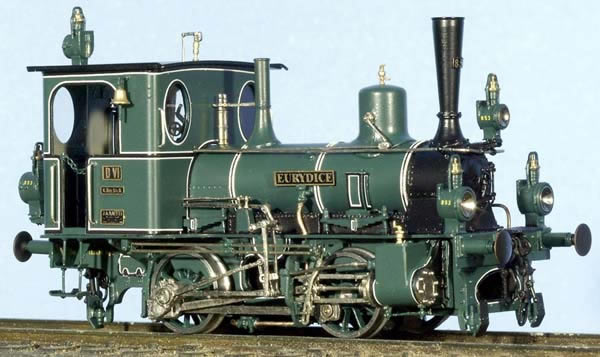
|
HO
|
04102H
|
Gattung D VI, No. 853 "Eurydice"
Königlich Bayerische Staatsbahn, Gattung D VI "Eurydice", No. 853, J. A. Maffei, München 1880, Bauzustand 1900, Localbahntenderlokomotive, Dampfbremse, Grün/Schwarz, Liniert Wei?Schwarz
|
°â§ą |
|
|
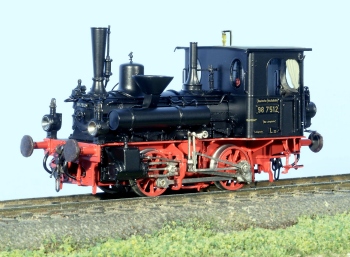
|
HO
|
04105H
|
Gattung D VI, No. 97.7512 (ex.
|
°â§ą |
|
|
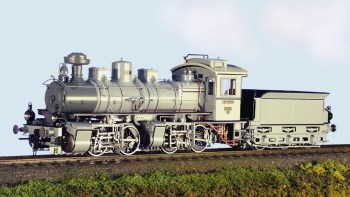
|
HO
|
05400H
|
Gattung IV, KSStEB No. IV.1251
Königlich Sächsische Staatseisenbahnen, Gattung IV, Mallet No. 1251, Hartmann/Chemnitz 1898, Bauzustand 1898, Tender Sächs. 3T9, Kobelschlot, kurzes Dach, Grau/Mittelgrau, Liniert Schwarz/Wei?&cost=0
|
°â§ą |
|
|
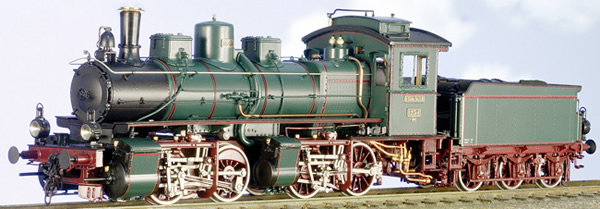
|
HO
|
05401H
|
The Saxonian Class IV Mallet was built in 1898 by Hartmann in Chemnitz Germany. The Class IV remained in service until the late 1920's. It was used mainly for freight service on mountainous terrain.
|
°â§ą |
|
|
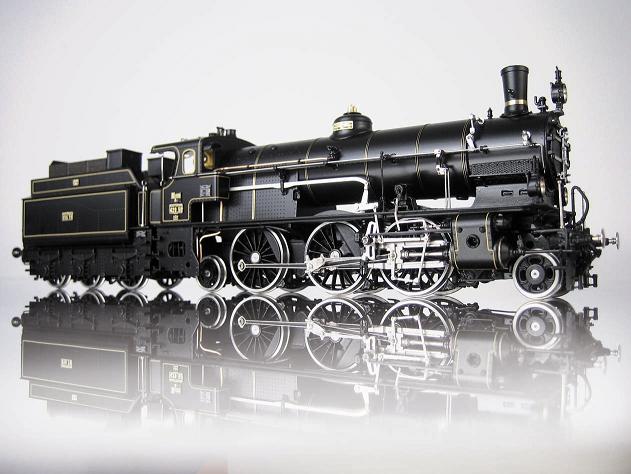
|
HO
|
05701H
|
Dampflok 429.51 K.K.Österr.Sts.B Ep1 schwarz
|
°â§ą |
|
|
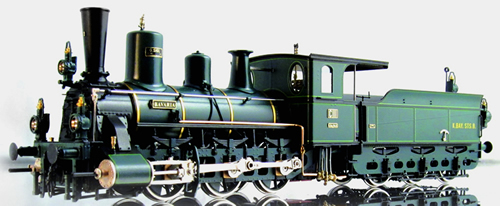
|
HO
|
06101H
|
Prototype Bavarian Version: The standard variant of the C III was developed from the C II. A total of 239 examples were built, which varied somewhat in their dimensions. For example, the third batch had a boiler diameter 30 mm greater than the others. The locomotives taken over by the Reichsbahn were to have been given the numbers 53 7871ˇV7990. However these locomotives were retired by 1925. Several engines were sent to Belgium as WWI war reparations.
|
°â§ą |
|
|

|
HO
|
06307H
|
French SNCF Era II Class 241A Black Livery1931 version with large smoke deflectors, black livery with red pin stripping and long dome streamlining.Prototype: The French class 241 was four cylinder compound locomotive built in 1931, it was one of the largest European locomotives ever built. The class 241 was a used for very heavy express service. With its large 1950mm drive wheels it reached a top speed of (110 km/h) 70 mph. The class 241's wheel arrangement was 4-8-2 which in the USA is known as a mountain. It was truly a magnificant locomotive weighing just over 200 tons. In 1953 the DDR Deutsche Reichsbahn East, purchased a class 241 and converted it to a coal dust burning locomotive. The DR classified it as a BR 08 and it was the largest locomotive in the DR fleet.One class 241 actually still runs today, it is the property of a professionally organized association in Boniswil Switzerland. This group purchased this locomotive some years ago and sent it to locomotive repair facilities in Meiningen Germany. The professional at Meiningen fully refurbished the class 241 to its original greatness and it occasionally hauls excersion trains. Today it is the largest functional steam locomotive in Europe, we hope to one day see this giant in person.Model: Well this might be the best Micro Metakit model yet. They will produce 8 different versions, six French and two German. Quantites naturally will be very limited. The model is completely functional and highly detailed. It will feature a functional replicated 4 cylinder drive system just like the prototype. The two inner pistons and crank shafts are functional and move in unison with the outer two pistons and drive rods. For a model this is a remarkable accomplishment. It also features a brush-less, ironless
|
°â§ą |
|
|
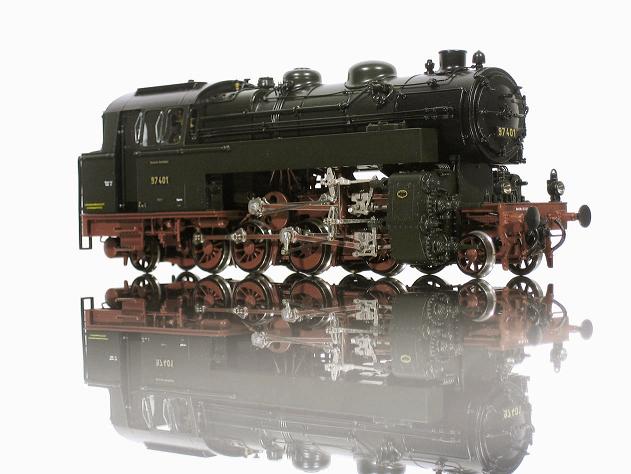
|
HO
|
07402H
|
Zahnrad-Adhäsionsdampflok 97.401 DRG Ep2 grün/braun/schwarz
|
°â§ą |
|
|
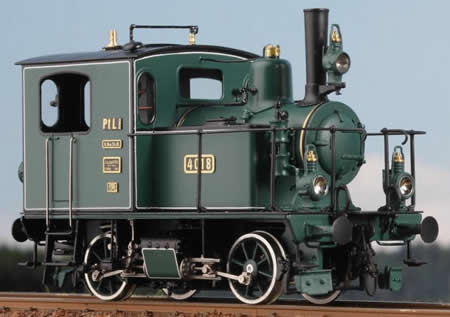
|
HO
|
08301H
|
The Class ML 2/2 locomotives of the Royal Bavarian State Railways(Königlich Bayerische Staatsbahn) were light and very compact superheated steam locomotive designed for services on branch lines (Lokalbahnen). They were a rival design by Maffer to the Bavarian PtL 2/2 or Glaskasten locomotives built by Krauss.
|
°â§ą |
|
|
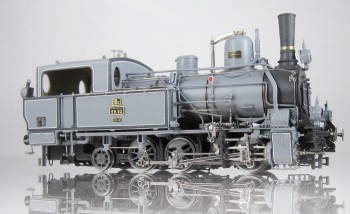
|
HO
|
08700H
|
Kaiserlich-königliche Österreichische Staatsbahnen, Reihe 69, No. 69.03, Zahnradlocalbahn, Vordernberg-Eisenerz "Erzbergbahn", Floridsdorf/Wien 1890, Fabrik-No. 734, Bauzustand 1890, Lackierung grau-dunkelgrau-schwarz, liniert
Hervorragende Laufeigenschaften, voll funktionsfähiges Zahnrad-Adhäsionstriebwerk mit hochuntersetzten Präzisionsgetrieben, komplett durchgestaltetes Außen- und Innentriebwerk, dem Original entsprechend hochdetaillierter Rahmenbau, vollständig nachgebildete Bremsanlage, freier Führerhausdurchblick ohne sichtbare Antriebsteile, ein hochkompliziertes Modell, handgefertigt in Messing, Neusilber und Edelstahl.
|
°â§ą |
|
|

|
HO
|
08701H
|
Kaiserlich-königliche Österreichische Staatsbahnen, Reihe 69, No. 69.05, Zahnradlocalbahn, Vordernberg-Eisenerz "Erzbergbahn", Floridsdorf/Wien 1892, Fabrik-No. 817, Bauzustand 1900, Lackierung schwarz-schwarz, liniert, zweite Bauserie ausgerüstet mit Saugluftbremse!
Hervorragende Laufeigenschaften, voll funktionsfähiges Zahnrad-Adhäsionstriebwerk mit hochuntersetzten Präzisionsgetrieben, komplett durchgestaltetes Außen- und Innentriebwerk, dem Original entsprechend hochdetaillierter Rahmenbau, vollständig nachgebildete Bremsanlage, freier Führerhausdurchblick ohne sichtbare Antriebsteile, ein hochkompliziertes Modell, handgefertigt in Messing, Neusilber und Edelstahl.
|
°â§ą |
|
|
|
˛Ł«~¦@24¶µ,
ĄŘ«e¦b1¶/¦@2¶
|
|